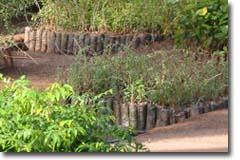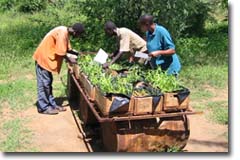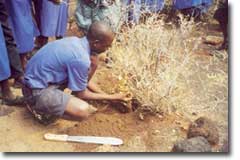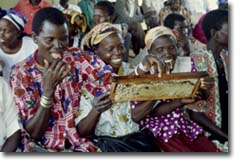|
|
Home > Activities
> Research
& Collaboration
|
 RAE's long term social and environmental
research is having a growing impact on dryland
development nationally and internationally. RAE's long term social and environmental
research is having a growing impact on dryland
development nationally and internationally.
Detailed
research records are kept by RAE on diverse aspects of
field and community activity, with most information
processed and evaluated on a regular basis. The
analysis and consolidation of long term research data,
as well as specific research projects, are often
carried out with collaborative partners. |
RAE
Research processed Every Quarter :
RAE carries out the collection, summary and
processing of data on all community activities, communal and private fields,
community pan dams, the RAE nursery, herbarium and
Clinic. Information reviewed and processed on a
quarterly basis by RAE field and office staff
includes: rainfall records,
level fluctuations of Lake Baringo, community meetings,
exchange tours and visitors, seedling management and distribution,
grass seed harvesting, distribution and sale, community and school extension
activities, private
field mobilisation, monitoring and evaluation, acreage
and location of planted fields, community field progress and condition (based on
monthly Field Recorder forms),
community contribution, benefit distribution, field off-take and
accounts, field management/ committees and groups
progress, and
primary and reproductive health care services. |
|

Tree seedlings in the RAE nursery

Germination experiments with different
grass species
|
Collaborative Research:
Researchers from various national and international research organisations and Universities visit and work with RAE each year. Many researchers come to carry out studies on RAE reclaimed fields using RAE’s long-term socio-economic and environmental data as a basis. Other researchers come to work with RAE on specific projects, often setting up a research framework that is then carried on by RAE personnel and expertise. Examples of such research include: biomass and disk meter measurements defining carrying capacity and grass productivity, live fencing experiments and survivability, germination and propagation trials on indigenous tree and grass species, regeneration and survivability of planted and regenerated species, collection and botanical documentation of indigenous tree and grass species for the RAE herbarium, recording ethno-botanical use and importance of indigenous species amongst three ethnic groups, soil analysis of reclaimed areas, comparative carbon sequestration measurements inside and outside reclaimed areas, and GIS mapping of RAE reclamation, important landmarks and environmental changes.
|
Schools and Universities:
RAE is committed to promoting awareness about dryland development and potential within the Kenyan educational system. As widely recognised this is sorely lacking, with an emphasis placed on high potential rather than dryland areas. At present, an increasing number of schools and Universities include RAE in their curriculum, with school field trips to RAE as part of geography courses or University students sent for short term attachments. The establishment of a more in-depth dryland training programme in collaboration with national and international Universities is currently under discussion.
|
|

Student planting seedling from
RAE nursery
|
| RAE also visits local schools to create environmental and health awareness, with RAE extension materials and tools such as the Kiswahili DVD 'Nyasi ni Pesa' ('improve your environment, increase your income') becoming increasingly important. In addition, RAE distributes tree seedlings, and is planting more and more school compounds with grass. As well as being an important teaching tool, grass fields have made it possible for some schools to keep improved cows and provide children with milk at lunch time. |
Visitors,
Collaboration and Partnerships:
RAE hosts up to 450 local, national and international
visitors annually, and numbers continue to increase.
Visitors come from a wide array of government and
non-government institutions and organisations, with an
increasing number of exchange visits from other
pastoralist groups. Although information dissemination is crucial,
tangible results experienced in the field, including
real benefits described by the local people
themselves, are usually what impress visitors most. A
growing number of visitors become collaborative
partners, working with RAE to promote diverse
activities in other dryland areas. A few examples of
active partnerships include: |
- • United Nations Development Programme (UNDP)
- • UNDP, Dryland Development Centre (DDC)
- • African Wildlife Foundation (AWF)
- • International Centre for Research in Agroforestry (ICRAF)
- • Earthwatch Institute
- • Kenya Forestry Research Institute (KEFRI)
- • Arid Lands Resource Management Project (ALRMP)
- • Ministry of Planning and National Development, Capacity 21 Project
- • Marie Stopes International
- • Honey Care Africa Ltd.
|
|

Training session in Baringo
conducted by Honey Care Africa Ltd.
|
|
|
|